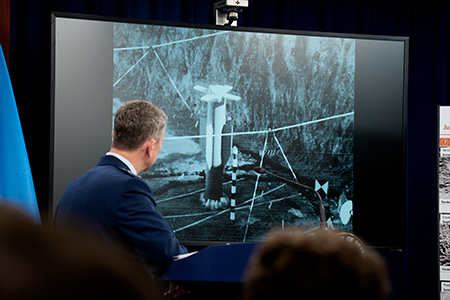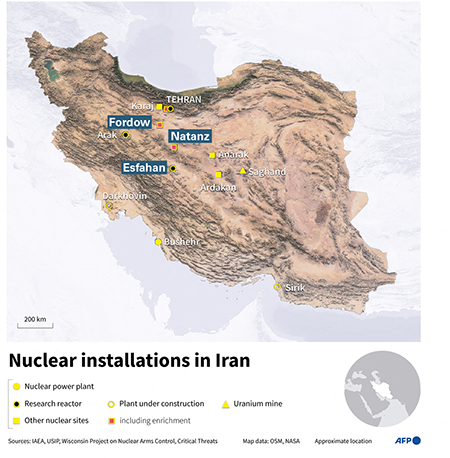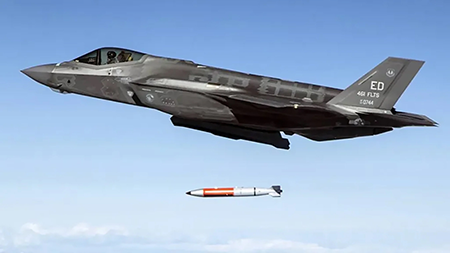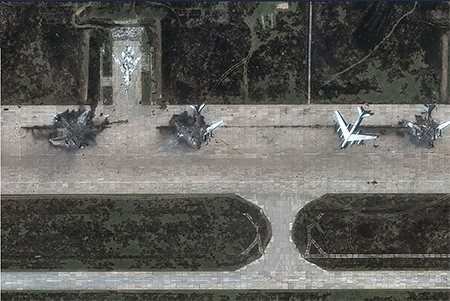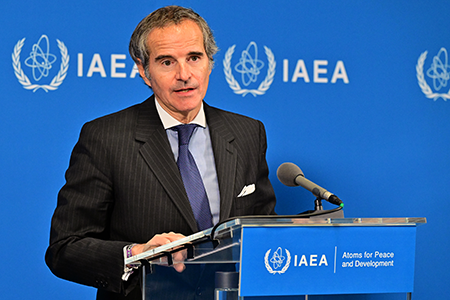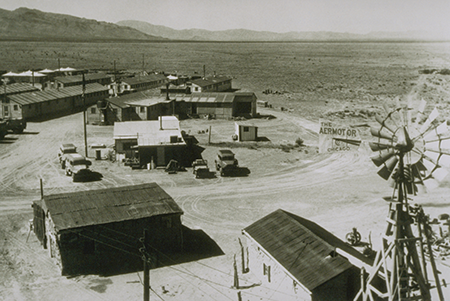Iran’s Nuclear Program After the Strikes: What’s Left and What’s Next?
The U.S. decision to join Israel’s strikes on Iran’s safeguarded nuclear facilities while negotiations on a nuclear agreement were ongoing dealt a serious blow to U.S. efforts to constrain Iran’s nuclear program. The premature use of force set back Iran’s nuclear program temporarily, but risks pushing Tehran closer to nuclear weapons in the long term. The U.S. strikes also complicate the diplomatic efforts that are still necessary to reach an effective, verifiable nuclear deal.
Volume 17, Issue 4, July 9
The U.S. decision to join Israel’s strikes on Iran’s safeguarded nuclear facilities while negotiations on a nuclear agreement were ongoing dealt a serious blow to U.S. efforts to constrain Iran’s nuclear program. The premature use of force set back Iran’s nuclear program temporarily, but risks pushing Tehran closer to nuclear weapons in the long term. The U.S. strikes also complicate the diplomatic efforts that are still necessary to reach an effective, verifiable nuclear deal.
Despite President Donald Trump’s claim that Iran’s nuclear program was “obliterated” by the U.S. and Israeli strikes, Iran has retained its nuclear weapons capability and critical materials to rebuild its program, giving Iran the option to quickly move back to the threshold of building nuclear weapons. Furthermore, Iran may be more motivated in the wake of the strikes to develop nuclear weapons to deter further attacks, particularly because there was no legal basis for the Israeli and U.S. military action. The risk that Iran’s political calculus will shift toward weaponization and its ability to reconstitute its nuclear program underscores the necessity of resuming diplomacy aimed at reaching a long-term deal to block Iran’s pathways to nuclear weapons, while providing Tehran with benefits in return.
Diplomacy is necessary, but it will be even more challenging post-strikes to reach a deal. The strikes created additional technical complexities—negotiators will now need to contend with uncertainties about Iran’s remaining infrastructure and the whereabouts of its stockpile of uranium enriched to near-weapons-grade levels. Politically, Trump’s decision to strike Iran undermined U.S. credibility at the negotiating table. Iranian President Massoud Pezeshkian told Tucker Carlson in an interview aired July 7 that the United States and Iran can resolve their differences and reach a deal that respects Iran’s rights, but said the strikes damaged Iran’s trust in the Trump administration’s willingness to negotiate in good faith. Pezeshkian asked how Iran “can know for sure that in the middle of the talks [with the United States], the Israeli regime will not be permitted to attack [Iran] again?”
The Trump administration will need to contend with these new political and technical challenges as it crafts its approach to negotiations. Although the strikes may have set Iran back, time is still short, as Iran retained enough of its nuclear program to quickly rebuild. The United States and Iran may need to consider interim measures that create the time and space for the time-consuming, complex negotiations necessary to reach a comprehensive agreement. Failure to prioritize pragmatic diplomacy now and consider creative win-win solutions increases the risk of further conflict and a nuclear-armed Iran.
Iran’s Nuclear Program and Diplomacy Pre-strikes
In the lead up to the Israeli strikes, Iran’s expanding nuclear program posed an urgent risk, but there was no evidence of an imminent threat of weaponization.
Iran began to accelerate its nuclear program in 2019, a year after Trump withdrew the United States from the Iran nuclear deal, known as the Joint Comprehensive Plan of Action (JCPOA), and reimposed sanctions, despite Iran’s compliance with the accord.
As a result of its advances, Iran reached the threshold of nuclear weapons, or point where it could develop nuclear weapons quickly, if the political decision were made to do so. Iran could have produced enough weapons-grade uranium for a bomb within days and enough for up to 10 bombs within weeks. Although this timeframe, known as breakout, was near-zero, the International Atomic Energy Agency (IAEA) had regular access to Iran’s uranium enrichment facilities and would detect if Iran moved to enrich uranium to weapons-grade levels or diverted its enriched uranium to an undeclared site.
Following the production of weapons-grade uranium, Iran would need to convert the uranium from gas to a metal form and assemble the explosives package, likely at covert, undeclared sites. Estimates for weaponization timeframe vary, but it would likely take months for Iran to build a crude nuclear explosive device and a year or more to build a warhead deliverable via ballistic missile. The weaponization process would be more challenging to detect and disrupt.
Iran’s threshold status did pose an urgent risk, but not an imminent threat. Iran had been sitting on the threshold status for more than a year before the Israeli strikes. Neither the United States, Israel, nor the IAEA presented any evidence suggesting that Iran decided to cross that threshold. On the contrary, the U.S. intelligence community continued to assess, including in the annual March 2025 Worldwide Threat Assessment, Iran was “not building a nuclear weapon” and that Iran’s Supreme Leader, Ayatollah Ali Khamenei, had not ordered Iran to weaponize its nuclear program.
In recognition of Iran’s proliferation risk, Trump in his second term, consistently emphasized his desire to negotiate a deal with Iran. While Khamenei was very cautious about the prospects for a deal due to Trump’s unilateral withdrawal from the JCPOA, he gave Pezeshkian space to negotiate with the United States. Iranian Foreign Minister Abbas Araghchi held five rounds of mostly indirect talks with U.S. Special Envoy Steve Witkoff and was slated to meet again on June 15 in Oman, two days after the Israeli strikes.
Although the United States and Iran had yet to resolve key issues necessary to negotiate a deal, such as whether Iran would be permitted uranium enrichment, the two sides were actively exchanging proposals. Neither Trump nor Pezeshkian gave any indication that the diplomatic route was exhausted. Trump touted progress in the talks during a May trip to Doha and, three days after the Israeli strikes began, told reporters that Iran was negotiating with the United States because it wanted a deal. In a July 8 oped in The Financial Times, Araghchi said negotiations were on the “cusp of a historic breakthrough,” prior to the Israeli strike.
Nothing from the U.S. intelligence community or the Israeli intelligence community suggested a significant shift in Iran’s thinking regarding weaponization in the days leading up to the strikes. On the contrary, when Israeli Prime Minister Benjamin Netanyahu announced the strikes on June 13, he reiterated the long-standing assessment that “Iran could produce nuclear weapons in a very short time. It could be a year. It could be within months.” He did not note any intelligence or evidence that Iran made the decision to weaponize.
Furthermore, the IAEA had regular, frequent access to Iran’s uranium enrichment facilities, Natanz and Fordow ahead of the strikes. The agency did not report any discrepancies or abnormal activities or diversion of enriched uranium at those locations.
These assessments from the IAEA and U.S. intelligence community and Trump’s own description of the prospects for a nuclear deal with Iran demonstrate that there was no legal basis for the U.S. strikes and that the diplomatic track was progressing.
The Israeli and U.S. Strikes on Iran’s Nuclear Sites
The Israeli strikes and subsequent U.S. bombing did significant damage to key Iranian nuclear sites, but the pace and targeting further support the assessment that the Israeli and U.S. decisions to attack were not driven by an imminent threat of weaponization. Assessments of the damage also rebut Trump’s assessment that Iran’s nuclear program was eliminated and suggest that Iran can rebuild its program.
In the first round of strikes on June 13, Israel’s only nuclear target was Natanz, which houses an above-ground pilot uranium enrichment plant and a larger, below-ground enrichment facility. Iran enriched uranium to 60 percent levels, a level just shy of the 90 percent considered weapons-grade, using advanced centrifuges (the machines used to enrich uranium) at the above-ground pilot facility, but the overall enrichment capacity of the pilot plant was small. The below-ground facility at Natanz housed the vast majority of Iran’s installed and operating centrifuges: 102 of Iran’s 126 cascades of centrifuges were installed at the Natanz Fuel Enrichment Plant. Of the 102 cascades, 83 were operational in May and used to enrich uranium to about five percent.
The IAEA assessed that the pilot uranium enrichment plant and the electric power supply building for the complex were destroyed in the June 13 strikes, and that the underground enrichment facility may have been penetrated. Even if Israeli strikes did not reach the below-ground facility, a sudden loss of power could have damaged the operational centrifuges installed in the plant.
Israel did not, however, even attempt to disrupt operations at the Fordow facility (Israel lacked the conventional capabilities to destroy the site), which arguably poses the greater proliferation risk. Although Fordow only contained 16 cascades of centrifuges (of which 7 cascades of IR-6 machines and 6 cascades of IR-1 machines were enriching uranium), Iran conducted the bulk of its enrichment to 60 percent at the site. Fordow, for instance, produced 166 kilograms of uranium enriched to 60 percent over the past quarter, compared to 19 kilograms produced at the Natanz pilot plant. Sixty percent enriched uranium poses a greater proliferation threat because it can technically be used for nuclear weapons (although it is unlikely Iran would build a device with 60 percent enriched material), and it can be quickly enriched to weapons-grade levels, or 90 percent.
Furthermore, Iran operated advanced IR-6 centrifuges at Fordow in a configuration that allows for more rapid switching between enrichment levels. The combination of the centrifuge configurations at Fordow and greater stocks of highly-enriched material (including the 20 percent enriched uranium Iran was using to produce 60 percent material), as well as its fortified location, highlights the proliferation risk posed by the site.
In a second round of strikes on June 13, Israel targeted the Esfahan nuclear complex, which houses several facilities used for uranium conversion activities and storing enriched uranium. The IAEA’s regular reports mention that Iran moved highly enriched uranium to Esfahan on several occasions, but it is not clear how much of the 400 kilograms of uranium enriched to 60 percent was stored there or if any was moved to the underground tunnels after the first Israeli strikes.
Specifically, the June 13 strikes on Esfahan targeted the facility where Iran converted uranium into the gas form (UF6) that is injected into the centrifuges, the facility where Iran had constructed (but never operated) a conversion line used to produce uranium metal, a fuel fabrication plant and a chemical laboratory. Iran declared to the IAEA that the purpose of the uranium metal facility would be to produce a metal form of reactor fuel, but it could also be used to fabricate the uranium metal components necessary for the core of a nuclear warhead. The IAEA had regular access to that facility and reported on May 31 that Iran had not produced any uranium metal during the previous quarter. Iran did produce small amounts of uranium metal in a laboratory at Esfahan, but none since 2021.
Israel struck the unfinished Khondab reactor, or IR-40, at the Arak site, on June 19. That reactor may have initially been designed to give Iran a plutonium pathway to nuclear weapons. However, the reactor’s design was modified under the JCPOA to produce a fraction of the weapons-grade plutonium that is necessary for a bomb on an annual basis and Iran continued to construct the facility based on that design. The IAEA did not report any deviations from that updated design before the strike, and it appeared that the facility was still years away from coming online. It did not pose a near-term proliferation risk.
Israel also illegally assassinated at least 14 nuclear scientists during the 12-day conflict, claiming that the individuals targeted had the specialized knowledge necessary to build nuclear weapons. Some were tied directly to Iran’s illicit pre-2003 nuclear weapons program. Israel claimed that the assassinations contribute to the setback of Iran’s program and will discourage other scientists from research relevant to weapons.
Eight days after the initial Israeli strikes, on June 21, the United States bombed the deeply buried Fordow uranium enrichment facility using 12 of the largest conventional weapons in the U.S. arsenal, the massive ordinance penetrator. Satellite imagery shows the impact of the U.S. strikes on Fordow, although it is unclear if the weapons penetrated the facility. IAEA Director-General Rafael Mariano Grossi, however, told the IAEA’s Board of Governors on June 23 that the vibrations from the explosions likely destroyed the centrifuges, even if the main facility was not hit.
The United States also targeted areas of Esfahan and Natanz. The submarine launched Tomahawk cruise missile strikes on Esfahan appear to have been aimed at collapsing the entrances to the tunnels where Iran was storing its enriched uranium. According to CNN reporting on a classified briefing for members of Congress, Chairman of the Joint Chiefs of Staff, General Dan Caine, said that the underground storage areas at Esfahan are too deeply buried for even the MOP to destroy, so the United States did not try to bomb at the complex and targeted the tunnel entrances instead. The strikes on Natanz, which used ground penetrating munitions, likely did further damage to the main underground uranium enrichment facility at that site.
In describing the purpose of the Israeli strikes, Prime Minister Benjamin Netanyahu said that Israel intended to “eliminate” Iran’s nuclear program. Given that Israel lacked the capabilities to destroy key facilities, such as Fordow, the comments suggest that Netanyahu intended to press the United States to join the attack from the onset, despite Trump’s previous resistance to military strikes and his focus on reaching a deal.
Trump described the U.S. strikes as a “spectacular military success” and said Iran’s nuclear program was “obliterated” as a result of the U.S. and Israeli military operations. An initial report from the Defense Intelligence Agency, however, said the strikes only set back Iran’s program a matter of months, according to CNN interviews with officials familiar with that report. A subsequent intelligence report assessed a greater setback of one to two years, according to Pentagon spokesperson Sean Parnell.
Trump, U.S. Secretary of Defense Pete Hegseth, and U.S. Secretary of State and interim National Security Advisor Marco Rubio all rebutted the initial report that assessed the program was set back only by months. Hegseth said the report was “preliminary” and that the nuclear program was “decimated.”
Rubio focused on the destruction of Iran’s uranium metal production facility as an indicator of the U.S. success in setting back the nuclear program. He said Iran cannot build a bomb “without a conversion facility,” which the strikes destroyed. Director of National Intelligence Tulsi Gabbard said it would take “years” for Iran to rebuild Natanz, Fordow, and Esfahan. An assessment from Israel’s Atomic Energy Commission made a similar assessment.
How Much Did the Strikes Actually Set Iran Back?
Although Iran has acknowledged that the strikes significantly damaged the nuclear facilities at Natanz, Fordow, and Esfahan, the assessments from senior Trump administration officials overinflated the effects of the U.S. strikes in setting back Iran’s program. It is impossible to destroy Iran’s nuclear program, given the irreversibility of the knowledge Iran has gained about the fuel cycle and from its pre-2003 nuclear weapons efforts. Furthermore, without on-the-ground inspections, it will be impossible to ascertain with certainty how much of Iran’s physical nuclear infrastructure was damaged. Even with access to the targeted sites, it would be challenging to determine what was destroyed and what Iran may have been diverted during the conflict.
It is also unclear what metric U.S. officials are using when measuring how much Iran’s program was set back. Is the setback in comparison to Iran’s pre-June 13 capacity? Or its ability to weaponize? Gabbard, for instance, said it would take Iran “years” to rebuild Natanz, Fordow, and Esfahan. It is not necessary, however, for Iran to completely rebuild all three facilities or pursue similarly sized uranium enrichment plants to return to the threshold of nuclear weapons.
Two of the key unknown variables in assessing Iran’s proliferation risk post-strike are the whereabouts of Iran’s uranium enriched to 60 percent and its ability to further enrich that uranium to weapons-grade levels. At the time of the Israeli strike, Iran had a stockpile of 408 kilograms of material enriched to 60 percent. If enriched to weapons grade – 90 percent uranium-235—that would be nearly enough for 10 weapons. Iran likely had some of this material at Natanz and Fordow, where enrichment to 60 percent took place, and some stored underground at the Esfahan complex. The IAEA does not report on the location of Iran’s stockpiles, only the amounts produced.
U.S. officials have admitted that Iran retains its stockpile of uranium enriched to 60 percent and that the whereabouts of the material is unknown.
After a June 28 Congressional briefing on the impact of the strikes, Representative Michael McCaul (R-Texas) said that his understanding “is that most of [the enriched uranium] is still there” and that the IAEA will need to account for the material. Similarly, Senator Linsey Graham (R-S.C.) said the HEU “wasn’t part of the targets.”
Although the United States may have rendered the tunnels to storage areas at the Esfahan complex inaccessible, Iran will likely be able to access the enriched uranium at that site, if it has not already done so. Satellite imagery taken in the days following the strikes suggests that Iran is already digging out at least one of the entrances.
More concerningly, Iran may have moved some of the 60 percent material to an unknown location. In a June 16 letter to the IAEA, Iran informed the agency it was taking “special measures” to protect its nuclear materials. Iran previously warned in May that it would take these actions in the event of a strike on its nuclear program. This suggests Iran had a contingency plan in place for transporting the enriched uranium in the event of an attack. The 60 percent material is stored in small canisters that would be relatively easy to move and disperse. Grossi confirmed in a June 29 interview that Iran’s actions likely included moving HEU, but that the IAEA does not know if or where the material was relocated after the Israeli strikes.
In addition to the stockpiles of enriched uranium that may have survived the strikes or been diverted to a covert location, Iran may also have stockpiles of centrifuges that survived the attacks. The IAEA has long warned that it cannot account for all of Iran’s centrifuges. The agency has not been able to access centrifuge manufacturing workshops since February 2021, when Iran suspended the additional protocol to its safeguards agreement, which gave inspectors more access and monitoring tools. As a result, the agency only observes the centrifuges when they are installed. Grossi explicitly raised the agency’s concerns about centrifuge stockpiles in November 2023, stating that the agency does not know where all of Iran’s centrifuges are.
From a capacity perspective, Iran could have produced centrifuges in excess of what it has installed since 2021. Iran’s known centrifuge production rates exceed the installation rates, raising the possibility that Iran has produced more machines than it deployed at Natanz and Fordow.
If Iran preserved a small number of more advanced machines, such as the IR-6 centrifuges that enrich uranium more efficiently, and a fraction of the stockpile of 60 percent material, Iran could build a covert facility with a small footprint relatively quickly.
But even if Iran’s centrifuges were all destroyed, Tehran could resume the manufacture of these machines. As Grossi noted, Iran retains that technical capability.
These “known unknowns” complicate efforts to assess Iran’s current proliferation risk and how much the program was set back. The time it would take for Iran to breakout (produce enough weapons-grade material for a bomb) if the decision were made to weaponize or return to a technical position to breakout, depends on a number of factors beyond the number and type of centrifuges and the amount of enriched uranium that may have survived, such as whether Iran has constructed an undeclared facility where it could begin enrichment or how quickly it could do so. In a worst-case scenario, Iran has already installed advanced machines at a site with a small footprint and moved 60 percent enriched uranium to that site. In that case, its breakout could be only weeks.
If Iran did decides to “breakout,” it would still need to weaponize, a process that would take months, if not a year. In making a case for the success of U.S. strikes, Rubio focused on the destruction of Iran’s uranium conversion facilities and argued that Iran can no longer convert its enriched uranium to the necessary metallic form for weaponization. That estimate also appears to overstate the success of U.S. strikes. It does appear that the facility at Esfahan housing Iran’s uranium metal conversion line was destroyed, but Iran could reconstitute this capability relatively quickly. Iran has recent experience developing a uranium metal processing line, even though it was ever completed. Furthermore, Iran produced small quantities of uranium metal in a research lab at Esfahan, suggesting that rebuilding a specialized facility may not be necessary. Iran may already have some or all of the necessary equipment to rebuild that capability or to repurpose a lab for conversion. If Iran makes the decision to weaponize and rebuilds a facility for processing uranium metal, conversion of weapons-grade uranium to metal may take only 1-3 weeks, according to IAEA estimates.
Further complicating the challenge in estimating how quickly Iran could rebuild its nuclear program and/or weaponize is a question of whether Tehran would prioritize speed or secrecy. The June 13 strikes demonstrate how thoroughly Israeli intelligence penetrated Iran. If Iran wants to weaponize or return to threshold status with a focus on secrecy, it may move more slowly and deliberately to minimize the risks of detection. By contrast, Iran could prioritize speed, which, depending on what materials survived the Israeli and U.S. attacks, could bring Iran back to the threshold in a matter of months.
Given these variables, it is challenging to say with any certainty how much the strikes set back Iran’s ability to breakout and weaponize. Ideally, the IAEA would be returning to Iranian nuclear facilities to begin the challenging process of trying to account for all of Iran’s enriched uranium, which would provide some additional clarity as to Iran’s current capabilities. However, Iran responded to the strikes by passing a law that bars cooperation with the IAEA, claiming, without evidence, that the IAEA was complicit in the strikes. The law, which came into effect on July 2, requires security guarantees for Iran’s nuclear facilities and scientists and an acknowledgement of Iran’s nuclear rights under the NPT, including the right to enrich uranium before Iran can resume cooperation with the agency.
The implications of the law for Iran’s implementation of its legally required safeguards agreement are not clear at this time. Araghchi stated that Iran is still committed to the NPT and its safeguards agreement. Grossi said in a June 29 interview with CBS that the agency is looking into how the law will impact the IAEA’s activities, but suggested that it may not be “incompatible” with the agency’s work. The IAEA did, however, withdraw its inspectors from Iran on July 4. Inspectors had remained present in the country, even though they did not have access to nuclear sites since the June 13 attacks.
If IAEA inspectors can return to Iranian sites, there may be more clarity about the status of Iran’s facilities and reporting on what infrastructure survived the attack. In that event, the agency’s focus will likely be on accounting for Iran’s nuclear material as required by the country’s safeguards agreement. Iran is unlikely to provide the IAEA with access beyond the sites and facilities covered by the country’s safeguards agreement, such as centrifuge production facilities. This suggests that it will remain challenging to assess Iran’s technical proximity to nuclear weapons and breakout capacity.
Iran’s technical capacity is not the only key factor in determining the country’s proliferation risk. How quickly Iran rebuilds its nuclear program and any move to weaponize will be a political decision. Iran’s political calculus regarding the costs versus the benefits of nuclear weapons may also shift as a result of the strikes.
In the immediate aftermath, there appears to be more public support in Iran for developing nuclear weapons in order to deter future attacks. Attacking safeguarded nuclear facilities that are part of Iran’s declared, peaceful program is also prompting Iranian officials to call into question whether NPT membership still provides benefits to Iran. Araghchi said on June 23 that Iran remains committed to the treaty, but that the U.S. attacks on Iran’s facilities has “called into question the effectiveness” of the NPT and “shaken” the nonproliferation regime. If Iran no longer perceives the NPT as contributing to its security and guaranteeing its peaceful program, that could drive Iran to determine that the perceived benefits of nuclear weapons outweigh the cost. In that scenario, Iran could seek to reconstitute a covert program to develop the bomb or withdraw from the NPT, paving the way to weaponize or deliberately create ambiguity about its nuclear program and intentions.
Options for Immediate Diplomacy
Iran’s irreversible knowledge about weaponization and the risk posed by the possible diversion of 60 percent enriched uranium and centrifuges underscore the necessity of negotiating a new nuclear agreement. As demonstrated by the JCPOA, an effective deal can limit Iran’s program for decades and put in place permanent, intrusive monitoring that provides greater assurance that any deviation from declared activities will be quickly detected.
Diplomacy, however, is now more politically and technically challenging. Given the difficulty in accounting for Iran’s enriched uranium stockpiles and its centrifuges after the strikes, it will likely be impossible for the IAEA to establish accurate, credible baselines to assess limits on certain nuclear activities in a future deal. If uncertainties persist about Iran’s stockpiles and centrifuges, more innovative monitoring mechanisms and intrusive access provisions might be necessary to compensate for the risk posed by possible missing materials. Designing an effective verification regime to account for these unknowns, however, will take time.
Politically, diplomacy is also now much more challenging now than it was prior to the strikes. The U.S. decision to bomb Iran before exhausting diplomacy will only amplify Iranian concerns about the trustworthiness of the United States and drive debate in Tehran about the value of remaining in the NPT. Despite Pezeshkian’s assertions that Iran is not interested in nuclear weapons development and that a deal is still possible, there is now a much higher risk that Iran will calculate that the United States is not negotiating in good faith.
Despite the challenges, both the United States and Iran appear open to resuming negotiations. In a July 2 interview, Araghchi said that negotiations may not restart quickly, but “the doors of diplomacy will never slam shut.” Trump’s references to the resumption of talks in mid-July suggest he has not ruled out diplomacy. Furthermore, Witkoff told CNBC that the United States still wants to pursue an agreement that would allow Iran to have a civil nuclear program without uranium enrichment, similar to the nuclear program in the United Arab Emirates. The UAE gave up enrichment and reprocessing in its nuclear cooperation agreement with the United States.
If U.S.-Iran talks do resume, both sides should keep three points in mind. First, given the additional technical complexities and the risk of a return to conflict, it would save time and reduce the likelihood of misinterpretation if Iran and the United States negotiate directly. Rubio suggested the United States would prefer direct talks.
Second, publicly staking out maximalist policy positions ahead of talks reduces flexibility at the negotiating table and risks driving the other party from the table before all options are explored. There are already indications that both sides will double down on their previous positions on enrichment, further entrenching disagreements that posed a challenge to negotiations pre-strike.
Trump, for instance, appears to believe that damaging Iran’s nuclear infrastructure will make Tehran more likely to accept zero enrichment in a nuclear deal. In the June 25 interview, Witkoff said “enrichment is a redline” for an agreement. If Trump insists on zero enrichment, an unnecessary condition for an effective deal, it may push Iran away from the negotiating table.
Iran, on the other hand, appears even less likely to give up enrichment so as not to be perceived as negotiating under pressure or capitulating post-strikes. The law banning cooperation with the IAEA enacted on July 2 requires a recognition of Iran’s “right to enrich” before inspectors can return to Iran, underscoring the political significance of enrichment. The law could box in Iranian negotiations and limit their flexibility.
Third, it is unlikely that an agreement can be successfully negotiated without input from the IAEA on what can and cannot be verified post-strikes, a process that will likely be time consuming.
The United States and Iran could consider an interim deal that would solidify the ceasefire, return the agency to Iran, and recognize Iran’s NPT rights. Such an agreement could reduce the risk of miscalculation while talks are onging and be endorsed by the Security Council.
As part of the Security Council endorsed arrangement, the United States could commit to refrain from further strikes against Iran, particularly safeguarded Iranian nuclear sites (or providing any support for Israeli strikes) so long as Iran commits to allowing IAEA inspectors to return to the country’s nuclear facilities and cooperates with efforts to account for the country’s nuclear materials. Iran would also commit not to attack U.S. forces or assets in the region. Pezeshkian has already said in a July 7 interview that Iran will not strike the United States if the United States refrains from attacking Iran.
The United States could further commit not to pursue punitive action against Iran at the IAEA Board of Governors for the time period during which safeguards were suspended or for uncertainties regarding material accountancy arising from the strikes, so long as the IAEA reports that Iran is cooperating with the agency to address safeguards issues.
To recognize Iran’s rights and concerns about the security of its nuclear sites, the UN Security Council resolution could also restate Iran’s NPT Article IV rights to a peaceful nuclear program and its Article III obligation to implement IAEA safeguards. It could further acknowledge that Iran enriched uranium under safeguards without specifying what future enrichment may look like under a comprehensive agreement. This formulation would acknowledge Iran’s rights and responsibilities under the NPT, without boxing in either side on the issue of enrichment. Language in the resolution could echo Grossi’s statements about the risks of military strikes on safeguarded nuclear facilities.
While the resolution would recognize Iran’s nuclear rights under the NPT and acknowledge its enrichment program, Iran could commit to suspend enrichment for an initial period while the agency is assessing Iran’s program and negotiations were ongoing. This will likely be necessary technically, given the damage done to Iran’s uranium enrichment facilities. It could be done with the understanding that the suspension is temporary and will not predetermine the enrichment issue in a final deal.
Given the damage to key Iranian nuclear facilities, Tehran is likely to view any remaining stockpile of 60 percent as critical negotiating leverage and will want to ensure the security of that material. An additional option could be for a third-party state (or states) to provide an additional security presence at the site housing Iran’s stockpile of enriched uranium. A Gulf State or China could be options that Iran would view as more trustworthy and whose presence may deter further attacks. Brazil, as a member of BRICS, and a country with uranium enrichment, could also be an option. A third-party presence, particularly if endorsed by the Security Council, could help address concerns that, once the location of the material is known, it would be vulnerable to Israeli strikes.
Additionally, a Security Council resolution could include language extending the deadline for the option to reimpose UN Security Council sanctions lifted as part of Resolution 2231, which endorsed the JCPOA. Under Resolution 2231, the option to reimpose the UN measures, which include a prohibition on uranium enrichment, using a mechanism that cannot be blocked, will expire in October 2025.
French Ambassador to the UN, Jerome Bonnafont, said that France, Germany and the United Kingdom will trigger snapback by the end of summer if there is no “robust, verifiable, and lasting diplomatic solution.” A verifiable deal by that deadline is not technically possible, post-strikes. Furthermore, Iran has threatened to withdraw from the NPT if snapback is triggered. The prospect of Iran following through on that threat is more likely now, post-strikes, given that officials are openly questioning the value of the treaty. Although the 90-day NPT withdrawal window could inject a sense of immediacy into the negotiating process, it is more likely at this juncture to further escalate tensions, heighten concerns that the true purpose of Iran’s nuclear program is a nuclear arsenal, and risk the fragile ceasefire.
Extending snapback for several years would create a longer window of time to negotiate a durable deal, while retaining the option to reimpose UN sanctions if diplomacy fails. Furthermore, if the E3 go ahead and snapback sanctions now, there is a real risk that many countries around the globe will oppose the reimposition of the UN sanctions and refuse to implement the measures, given that the United States and Israel disrupted previous diplomatic efforts and conducted illegal strikes against the nuclear program. Opposition to the reimposition of sanctions would be damaging to future nonproliferation efforts, as well as specific efforts to negotiate a deal with Iran.
As part of the interim agreement, the United States could commit to allowing Iran to sell additional oil and opening up Iranian assets stored in Qatar to pay not only for humanitarian goods, but also equipment and materials to help with addressing the environmental and civil impacts of the Israeli strikes on non-miltiary, non-nuclear sites.
Such an interim agreement along these lines would create time and space for diplomacy, while providing benefits and addressing some of the immediate concerns on both sides.
A Longer-Term Framework
It would behoove both the United States and Iran to begin thinking now about new, creative frameworks for a sustainable deal that take into account the technical challenges created by the U.S. and Israeli strikes. This should include looking at innovative monitoring mechanisms to compensate for uncertainties that may persist about Iran’s stockpiles of HEU and other materials, and regional options that would add layers of transparency. Creative options will also likely be necessary for thinking about the future of Iran’s nuclear infrastructure.
One option in a bilateral U.S.-Iran deal would be for Washington and Tehran to agree on the reintroduction of Iranian enrichment if or when a practical need emerges. If, for example, when Iran meets a certain milestone in the construction of a new reactor, it could begin reinstallation of a specified number of centrifuges to produce enough fuel commensurate with the needs of the reactor. Enrichment would take place under intrusive monitoring. Iran could be permitted to retain any remaining 60 percent enriched uranium under IAEA monitoring as a guarantee until it begins enriching again. At that point, the 60 percent material could be blended down.
A bilateral deal could also include civil nuclear cooperative projects that incentivize Iranian focus on proliferation-resistant, nationally beneficial projects. This could include supporting the construction of a new, proliferation-resistant medical isotope research reactor, in acknowledgement of the unfinished reactor at Arak that Israel destroyed.
Another option could be the creation of a multilateral enrichment consortium, an idea under discussion prior to the strikes. Regional states could help Iran finance rebuilding an enrichment facility in an agreed-upon location. Another option could be the construction of two multilateral facilities, one inside Iran and one in a Gulf State. This formula would allow Iran to retain enrichment domestically, while adding a layer of transparency and oversight from a consortium. The longer time frame for negotiations could help facilitate the more complicated negotiations on a multilateral arrangement.
A variation of this option could be an Iran-Saudi Arabia agreement, whereby uranium is enriched in Iran and fuel is fabricated in Saudi Arabia. This could be a more attractive option if both sides pursue similar reactors for their civil nuclear programs that require the same fuel.
To layer on additional transparency in the region, the United States, E3, and China could commit to helping construct and equip a regional nuclear security center, where Iran and the Gulf States could collaborate on training, response, and mitigation exercises, nuclear security governance, and other areas of shared concern. A variation on this would be a joint nuclear research center that could provide shared space to work on the application of nuclear science to areas like agriculture or medicine. This would not be a replacement for a nonproliferation deal but would create stronger ties between scientific communities in Iran and the Gulf States that support transparency and direct efforts toward nationally beneficial nuclear research that poses less of a proliferation risk.
Moving Forward
The U.S. and Israeli strikes on Iran’s nuclear facilities may have set back Iran’s program, but the attacks were not a legal, effective, or sustainable nonproliferation policy. On the contrary, Trump dealt a serious blow to the NPT by attacking Iran’s safeguarded nuclear facilities while negotiations were ongoing and there was no evidence of weaponization. Failing to return to talks with the goal of negotiating a deal that addresses both U.S. and Iranian concerns will only increase Iran’s proliferation risk and further erode the treaty. An effective, verifiable nuclear agreement, on the other hand, could incentivize Iran to remain in good standing within the NPT and focus on civil nuclear activities that pose less proliferation risk, while blocking Iran’s pathways to nuclear weapons for decades to come.—KELSEY DAVENPORT, director for nonproliferation policy

